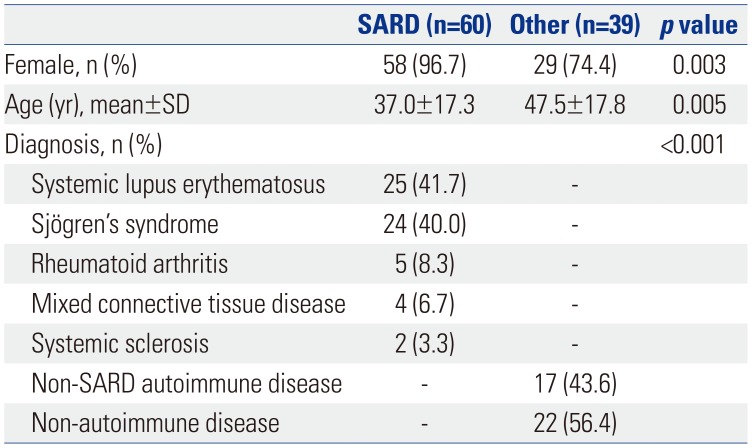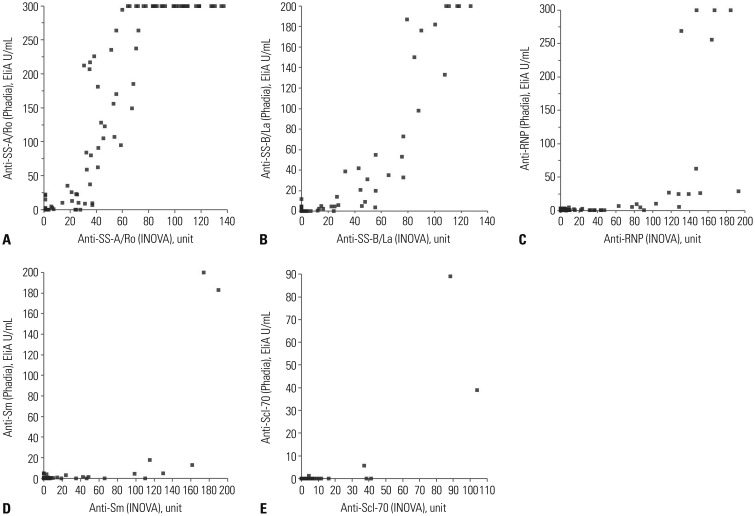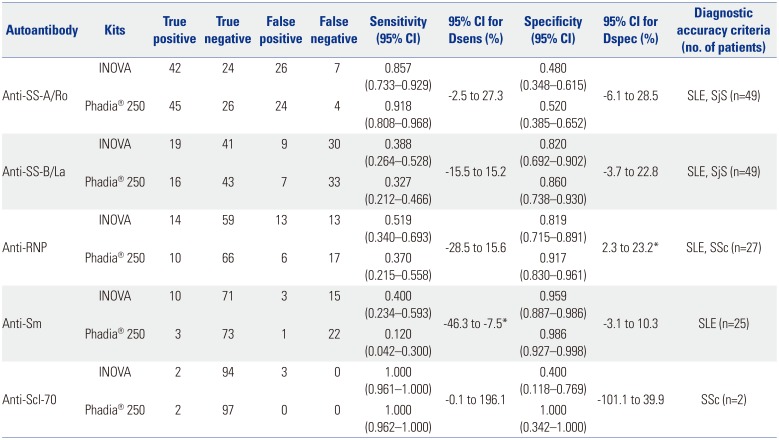1. Egner W. The use of laboratory tests in the diagnosis of SLE. J Clin Pathol. 2000; 53:424–432. PMID:
10911799.

2. van Venrooij WJ, Charles P, Maini RN. The consensus workshops for the detection of autoantibodies to intracellular antigens in rheumatic diseases. J Immunol Methods. 1991; 140:181–189. PMID:
1906075.

3. Catoggio LJ, Bernstein RM, Black CM, Hughes GR, Maddison PJ. Serological markers in progressive systemic sclerosis: clinical correlations. Ann Rheum Dis. 1983; 42:23–27. PMID:
6402991.

4. Kayser C, Fritzler MJ. Autoantibodies in systemic sclerosis: unanswered questions. Front Immunol. 2015; 6:167. PMID:
25926833.

5. Migliorini P, Baldini C, Rocchi V, Bombardieri S. Anti-Sm and anti-RNP antibodies. Autoimmunity. 2005; 38:47–54. PMID:
15804705.

6. Meroni PL, Biggioggero M, Pierangeli SS, Sheldon J, Zegers I, Borghi MO. Standardization of autoantibody testing: a paradigm for serology in rheumatic diseases. Nat Rev Rheumatol. 2014; 10:35–43. PMID:
24275965.

7. Albon S, Bunn C, Swana G, Karim Y. Performance of a multiplex assay compared to enzyme and precipitation methods for anti-ENA testing in systemic lupus and systemic sclerosis. J Immunol Methods. 2011; 365:126–131. PMID:
21184759.

8. Siracusano A, Agelli M, Ioppolo S, Quintieri F, Bombardieri S. Detection of anti-extractable nuclear antigens in connective tissue diseases: comparison between passive hemagglutination, counterimmunoelectrophoresis and double immunodiffusion. Ric Clin Lab. 1985; 15:33–38. PMID:
3922039.

9. Lynes MA. Solid-phase immunoassays. Curr Protoc Toxicol. 2005; Chapter 18:Unit18.7.

10. Chen YJ, Chen M, Hsieh YC, Su YC, Wang CH, Cheng CM, et al. Development of a highly sensitive enzyme-linked immunosorbent assay (ELISA) through use of poly-protein G-expressing cellbased microplates. Sci Rep. 2018; 8:17868. PMID:
30552393.

11. Pereira KM, Dellavance A, Andrade LE. The challenge of identification of autoantibodies specific to systemic autoimmune rheumatic diseases in high throughput operation: proposal of reliable and feasible strategies. Clin Chim Acta. 2014; 437:203–210. PMID:
25091804.

12. Jeong S, Hwang H, Roh J, Shim JE, Kim J, Kim GT, et al. Evaluation of an automated screening assay, compared to indirect immunofluorescence, an extractable nuclear antigen assay, and a line immunoassay in a large cohort of Asian patients with antinuclear antibody-associated rheumatoid diseases: a multicenter retrospective study. J Immunol Res. 2018; 2018:9094217. PMID:
29854849.

13. Au EY, Ip WK, Lau CS, Chan YT. Evaluation of a multiplex flow immunoassay versus conventional assays in detecting autoantibodies in systemic lupus erythematosus. Hong Kong Med J. 2018; 24:261–269. PMID:
29807953.

14. TDR Diagnostics Evaluation Expert Panel. Banoo S, Bell D, Bossuyt P, Herring A, Mabey D, Poole F, et al. Evaluation of diagnostic tests for infectious diseases: general principles. Nat Rev Microbiol. 2010; 8(12 Suppl):S17–S29. PMID:
21548184.

15. Elrefaei M, Boose K, McGee M, Tarrant TK, Lin FC, Fine JP, et al. Second generation automated anti-CCP test better predicts the clinical diagnosis of rheumatoid arthritis. J Clin Immunol. 2012; 32:131–137. PMID:
22072115.

16. Viera AJ, Garrett JM. Understanding interobserver agreement: the kappa statistic. Fam Med. 2005; 37:360–363. PMID:
15883903.
17. Altman DG, Machin D, Bryant TN, Gardner MJ. Statistics with confidence. 2nd ed. London: BMJ Books;2000.
18. CLSI. User protocol for evaluation of qualitative test performance; approved guideline—second edition. CLSI document EP12-A2. Wayne, PA: Clinical and Laboratory Standards Institute;2008.
19. van der Pol P, Bakker-Jonges LE, Kuijpers JHSAM, Schreurs MWJ. Analytical and clinical comparison of two fully automated immunoassay systems for the detection of autoantibodies to extractable nuclear antigens. Clin Chim Acta. 2018; 476:154–159. PMID:
29170107.

20. Banhuk FW, Pahim BC, Jorge AS, Menolli RA. Relationships among antibodies against extractable nuclear antigens, antinuclear antibodies, and autoimmune diseases in a Brazilian public hospital. Autoimmune Dis. 2018; 2018:9856910. PMID:
30364021.

21. Lee SA, Kahng J, Kim Y, Park YJ, Han K, Kwok SK, et al. Comparative study of immunofluorescent antinuclear antibody test and line immunoassay detecting 15 specific autoantibodies in patients with systemic rheumatic disease. J Clin Lab Anal. 2012; 26:307–314. PMID:
22811366.










 PDF
PDF ePub
ePub Citation
Citation Print
Print



 XML Download
XML Download